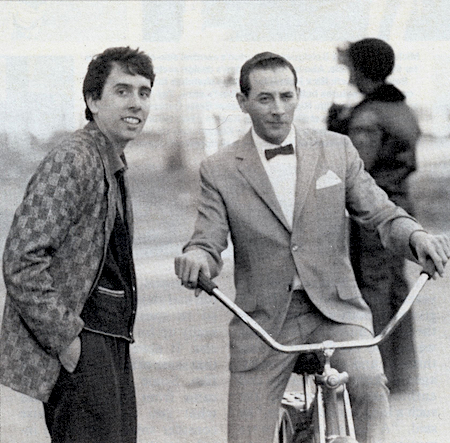August 9, 1985
In an attempt to put a finger on the ineffable singularity of PEE-WEE’S BIG ADVENTURE, let us consider the Rube Goldberg machines of Summer of 1985 so far:
THE GOONIES. First scene after the prologue. Mikey pulls a string that drops a bowling ball into a bucket and sets off a chain reaction that involves a balloon, a hen, a football and a sprinkler, just to pull open the gate for Chunk. Why? I don’t know. Because it’s cute. Its cool. Kids like it. No reason needed.
 BACK TO THE FUTURE. Opening titles. A series of timers act as Doc Brown’s breakfast machine. The coffeemaker turns on, an alarm swings an arm that flips a switch that turns on the morning news, the toaster is toasting, a can of dog food slides down to a robot arm that swings around to a can opener that opens it and it dumps into a dog bowl. It’s not as elaborate or chain reaction based as the GOONIES machine, but it’s more organic to the story because it’s the work of an inventor who’s a genius and a nut and interested in time. And also maybe Steven Spielberg is just into these things, since he produced both movies.
BACK TO THE FUTURE. Opening titles. A series of timers act as Doc Brown’s breakfast machine. The coffeemaker turns on, an alarm swings an arm that flips a switch that turns on the morning news, the toaster is toasting, a can of dog food slides down to a robot arm that swings around to a can opener that opens it and it dumps into a dog bowl. It’s not as elaborate or chain reaction based as the GOONIES machine, but it’s more organic to the story because it’s the work of an inventor who’s a genius and a nut and interested in time. And also maybe Steven Spielberg is just into these things, since he produced both movies.
And now, PEE-WEE’S BIG ADVENTURE. Again, the first scene after the prologue. Another breakfast machine. After getting out of bed in the morning, Pee-wee Herman (Paul Reubens in his followup to MEAT BALLS PART II) tells his dog Speck, “Come on, let’s get some breakfast!” He turns on a fan and lights a candle under a string. The reaction involves a row of interlocked pinwheels, a dropping anvil, a toy ferris wheel… this one could be an homage to the one in CHITTY CHITTY BANG BANG, but with the addition of kitsch: an egg rolls through a tube and is cracked open by a Drinking Bird, wooden models of dinosaur skeletons carry bread slices and squeeze oranges, an Abraham Lincoln statue flips pancakes. As the meal is made (and the dog food is served) the orchestral score builds from dreamy, tinkly chimes to a booming, stomping anthem. And in the end the food is somehow plated with eggs for eyes, a strawberry for a nose and bacon strips for lips. Pee-wee calls him “Mr. Breakfast,” and they seem to already be acquainted. For his own breakfast, Mr. Breakfast requests Mr. T Cereal.
Unlike Doc Brown, Pee-wee is not (in this movie) an inventor. There’s no narrative reason why he would or could create something like this. But his overwhelming dedication to play, absurdity and nonsense mean it would be ludicrous and unacceptable for him to not start off his day like this. The sequence is pure Pee-wee Herman, pure (first time feature director) Tim Burton and pure (first time orchestral score composer) Danny Elfman. It is their sense of humor, their style, their personality. This is the third major Rube Goldberg device of the Summer of 1985 movie season, and – nothing against those other two – this time it feels like the gimmick has achieved its ultimate form.

I think you all know what the movie is, but I’ll go over the basics. Pee-wee’s beloved bike (a 1947 Schwinn Western Flyer tricked out with fins, a plastic tiger head siren and James Bond gadgets like an ejector seat) is stolen on behalf of his bratty rich kid rival Frances Buxton (played by another adult – Mark Holton, two episodes of Webster). A scamming fortune teller (Erica Yohn, THE GODFATHER PART II) tells Pee-wee his bike is in the basement of the Alamo, so he embarks on a road trip to get it back. Along the way he befriends various timeless movie archetypes including but not limited to an escaped convict on the lam (Judd Omen, RED DAWN), a truck driver who’s actually a ghost (Alice Nunn, THE FURY), a rail-riding hobo (Carmen Filpi, “Bum,” ESCAPE FROM NEW YORK), and a biker gang called The Satan’s Helpers. When his talks with a small town diner waitress with big dreams (Diane Salinger, CREATURE) are misinterpreted (“Everyone I know has a big ‘but.’ C’mon Simone, let’s talk about your big ‘but,’”) he gets chased around by a jealous, grunting boyfriend (Jon Harris, a.k.a. 7’ 7” A.W.A. wrestler Silo Sam) who seems like a live action Bluto. During his adventure, Pee-wee sneaks past a road block in disguise, drives off a cliff, accidentally enters a rodeo, is hospitalized after a motorcycle accident, is involved in a high speed chase on the Warner Brothers backlot, and makes a cameo in a movie based (very loosely) on his own life.
 It’s a very traditional plot structure; in figuring out how to bring his popular Groundlings, off-Broadway and HBO special character to the big screen, Reubens bought the book Screenplay by Syd Field, and he and co-writers Phil Hartman and Michael Varhol followed the prescribed formula exactly. We may or may not need this sturdy skeleton to ground us in Pee-wee’s world, where everyone and everything is heightened, but it works great. Burton’s past making misfit shorts at Disney comes in handy for hand-crafted cartoon gags: Pee-wee becoming an animated pair of eyes in the dark, a stop motion t-rex terrorizing him in his nightmares, and of course the animated googly eyes of Large Marge, cinema’s funniest jump scare.
It’s a very traditional plot structure; in figuring out how to bring his popular Groundlings, off-Broadway and HBO special character to the big screen, Reubens bought the book Screenplay by Syd Field, and he and co-writers Phil Hartman and Michael Varhol followed the prescribed formula exactly. We may or may not need this sturdy skeleton to ground us in Pee-wee’s world, where everyone and everything is heightened, but it works great. Burton’s past making misfit shorts at Disney comes in handy for hand-crafted cartoon gags: Pee-wee becoming an animated pair of eyes in the dark, a stop motion t-rex terrorizing him in his nightmares, and of course the animated googly eyes of Large Marge, cinema’s funniest jump scare.
The distinct tone and style are instantly understandable but difficult to describe. Seeing it in the theater as a youth, it seemed like the funniest movie ever. As I got older it was one of my most repeatedly rented tapes, and after 35 years of this it not only holds up, but takes on new dimensions. In February I was lucky enough to see it with a big crowd and subsequent 90 minute talk by Reubens for this year’s anniversary tour – the last big pre-Covid event I attended – and I still enjoyed watching it again this week.
There are so many types of jokes. Corny ones like Mickey having been imprisoned for taking a tag off a mattress. Personality-based ones like Pee-wee rejecting Dottie’s advances by pretending to be a loner (and then cracking up when he turns his back). And so many performance-based ones, like Pee-wee’s terrible stint as an extra in the movie-within-the-movie, awkwardly centering himself in the frame, looking at the director, seemingly getting in trouble and turning to look away.
One of BIG ADVENTURE’s top 100 or so most beloved jokes is defined by its complete lack of context. During an overblown neighborhood meeting about the theft of his bike, Pee-wee suddenly admonishes someone for whispering during his presentation. “Is this something you can share with the rest of us, Amazing Larry?!” he yells at a man in his ‘50s sporting a colorful mohawk. The deleted scenes on the DVD contain the explanation for why this man would have that name and hairdo (don’t worry, I won’t give it away), and it would’ve been a funny joke. Removing the setup, turning the punchline into a bizarre mystery, makes it a legendary joke. And it’s the kind of movie where that fits in perfectly.
Lately the little touch of absurdity that amuses me most is the outcome of the famous “Tequila” scene, where Pee-wee convinces the biker gang who are about to kill him to let him do a dance on top of the bar first. After the song it cuts to what must be hours of drinks later when they leave the bar, arms around Pee-wee, now so enamored of him they’ve given him one of their vests and motorcycles. (Even funnier: the cut from his immediate wipe out to the caravan of bikes escorting his ambulance to the hospital.)
You see a scene so many times you take it for granted, and then years later you remember how little sense it makes. For some reason they went from planning to murder this guy to treating him like a family member… because he did a funny dance for them. That’s how Pee-wee wants the world to be. Beautiful.
This is a movie that doesn’t take itself seriously for one second, yet it seems entirely sincere, including in its notion that Pee-wee Herman can be an honorary Satan’s Helper, because he can get along with anyone but Francis Buxton. True, he’s often a selfish brat, but that’s always the joke. The point of view of the movie itself (and virtually all of the Pee-wee-ography) is one of non-judgment. Other than Francis and entitled child star Kevin Morton (Jason Hervey, POLICE ACADEMY 2), I don’t think there’s a character in the movie that Burton dislikes. And even Francis gets to play giant monster in the swimming pool, which is something Pee-wee would also do.
The hero of 1985’s biggest hit, BACK TO THE FUTURE, is supposed to represent some kind of accessible ‘80s cool. Marty McFly plays electric guitar, rides a skateboard, tries to teach the squares of 1955 about rock ’n roll before they’re ready. Pee-wee works by going in the opposite direction. He wears a fucking bow tie, his suit and hair are both cut to look unflattering. He’s so entirely uninterested in hipness that he becomes much more hip than the guy wearing sunglasses with his collar flipped up – even while residing in a world where “edginess” doesn’t exist. Burton injects his creepy (cartoony) imagery into the nightmare sequences, but there’s no cynicism, no real darkness. Even BACK TO THE FUTURE has an attempted rape and Libyan terrorists shooting a beloved character with uzis. That BIG ADVENTURE can be so thoroughly nonconformist while being purely joyful seems almost subversive to me.

BACK TO THE FUTURE and THE HEAVENLY KID look back at the ‘50s and early ‘60s with nostalgia and, by going backwards to show how the parents of suburban ’80s teens got together and provided for them, they reaffirm some of the family values associated with that period. Pee-wee instead celebrates only the surface of past eras – the trinkets and totems and design aesthetics, horded and crammed together in mass quantities – while casually ignoring societal expectations for his lifestyle. Somehow he owns a nice all-American house, but its white picket fence encases statues of livestock, several Native Americans with a horse and a teepee, Santa Claus, a deep sea diver, gnomes, a rocket – a random assortment of clutter that would outrage any neighborhood association. During the era when American males worshiped the Trans-Am, the Ferrari and the Lamborghini, Pee-wee pampers and flaunts an old bicycle. He talks like a little boy, obeys no laws of masculinity, and according to his scale is literally a 98-pound weakling. He lives alone, no apparent interest in a wife or kids, and goes out of his way to not even acknowledge interest from his female friend Dottie (Elizabeth Daily, STREETS OF FIRE). Pee-wee doesn’t give a fuck.
Yet not one person seems to object to him. He’s friends with everyone in his neighborhood from the old man next door to the local bicycling community to the owner of the magic shop to Amazing Larry. And everywhere he stops from California (?) to the Alamo he makes new friends, all of whom he remembers to invite to his movie premiere. Even Francis’s rivalry with him is about jealousy, about money not being able to buy him everything Pee-wee has. He doesn’t think Pee-wee is a weirdo. He probly wishes he was him.
 And just like Pee-wee violates all notions of how an adult man is supposed to live his life, Reubens and Burton – the latter finally free of bosses who say his work is great but too weird to use – broke numerous unwritten rules of ‘80s filmmaking. Instead of trying to create a relatable everynerd like Marty or Gary and Wyatt, or a cool smartass like Brewster or Fletch, they give us a bizarre manchild who defies any possibility of backstory, explanation or identification. At the height of the Lucas/Spielberg/ILM era of innovation they chose intentionally crude and lo-fi FX. Arguably the “Tequila” scene fits the mold of the BACK TO THE FUTURE “Johnny B. Goode” oldie-based set piece, but this was the era of pop theme songs, and they hired the same guy who did that for WEIRD SCIENCE… to try to figure out how the fuck to do an orchestral score. Even today it’s rare to make an all-out comedy that’s so concerned with visual style and world building; most directors just point the camera at the guy saying the funny thing and then go have lunch. Here’s a movie where no one would doubt that both the director and the star personally fussed over every last prop in a given shot. These guys do it their own way, not knowing another way, not being interested in another way, not particularly caring about whichever dumb motherfucker would think they were doing it wrong.
And just like Pee-wee violates all notions of how an adult man is supposed to live his life, Reubens and Burton – the latter finally free of bosses who say his work is great but too weird to use – broke numerous unwritten rules of ‘80s filmmaking. Instead of trying to create a relatable everynerd like Marty or Gary and Wyatt, or a cool smartass like Brewster or Fletch, they give us a bizarre manchild who defies any possibility of backstory, explanation or identification. At the height of the Lucas/Spielberg/ILM era of innovation they chose intentionally crude and lo-fi FX. Arguably the “Tequila” scene fits the mold of the BACK TO THE FUTURE “Johnny B. Goode” oldie-based set piece, but this was the era of pop theme songs, and they hired the same guy who did that for WEIRD SCIENCE… to try to figure out how the fuck to do an orchestral score. Even today it’s rare to make an all-out comedy that’s so concerned with visual style and world building; most directors just point the camera at the guy saying the funny thing and then go have lunch. Here’s a movie where no one would doubt that both the director and the star personally fussed over every last prop in a given shot. These guys do it their own way, not knowing another way, not being interested in another way, not particularly caring about whichever dumb motherfucker would think they were doing it wrong.
Recruiting Elfman to do the score changed movies. It was such an outside the box notion that Elfman himself didn’t think it made sense. He and Oingo Boingo had done the musical FORBIDDEN ZONE, but that was a rock/new wave band. He wasn’t in the market to become a film composer, and didn’t even think he would be able to do it. In 1990 he told the Washington Post, “Tim said he was interviewing primarily nontraditional composers, that he had heard my music with the band and thought he heard bits of orchestral or filmatic potential. I didn’t agree with him. But I’m glad that he persisted, because I have a career out of it.”
(So in a world where Burton got to do Frankenweenie in stop motion like he wanted we never would’ve had Tim Burton the live action director or Danny Elfman the film composer.)
Oingo Boingo lead guitarist Steve Bartek, having more musical training than Elfman, came along as his arranger, and they made a timeless carnival of a score completely unlike other movies of the era, occasionally imitated but never duplicated, much like the movie itself.
It’s hard to believe now, but according to the book Inside Pee-wee’s Playhouse: The Untold, Unauthorized, and Unpredictable Story of a Pop Phenomenon by Caseen Gaines, Warner Brothers was so befuddled by the finished movie that they considered not releasing it. “The studio executives were doubtful that the film would attract an audience and some thought it might be better to cut their losses instead of spending the money making prints of the film and publicizing it across the nation. Reubens and his team were crushed.”
But the producers convinced the studio to screen it in three cities, and strategically chose Austin as one of the locations, “a city that had had a particularly strong outpouring of support among college students during the Pee-wee Herman Party tour a year earlier.” The response convinced the studio to release the film after all.
Though August is often a dumping ground for movies studios don’t believe in, they did book Reubens to promote the movie in character on various TV shows, and he even hosted an MTV broadcast of the Hollywood premiere, interviewing and/or taunting the red carpet arrivals of Eddie Murphy, Alice Cooper, The Fat Boys, Mr. T, Steve Martin, David Lee Roth and others.
When PEE-WEE’S BIG ADVENTURE opened wide it went to #3, behind BACK TO THE FUTURE (week 6) and SUMMER RENTAL, and went on to make $40 million on a $7 million budget. I know from my experience that many people loved it immediately, but apparently some didn’t. On Siskel & Ebert, Gene “hated” the movie “from start to finish” so much that he chose it to be on their Worst of the Year special. He sounded pissed as he said he was a fan of Pee-wee on Letterman and tried to see him live, but “didn’t think he was funny at all in the movie. I was shocked.” Roger had been on vacation when it was released and hadn’t seen it, but later referred to it as “magical” in a review of its sequel.
I know you’re supposed to say your favorite comedy of the ‘80s is GHOSTBUSTERS or PRINCESS BRIDE or THIS IS SPINAL TAP or something, but I believe PEE-WEE’S BIG ADVENTURE may be mine. (The other possible contenders are RAISING ARIZONA and THE BLUES BROTHERS.) It’s so god damn funny and original, and it shows the value of approaching art – and life – from the perspective of enthusiastic outsiders who just don’t know any better than to be themselves. When you do that, you can do things other people couldn’t understand. Things they shouldn’t understand. PEE-WEE’S BIG ADVENTURE is the best.
NOTES:
Summer of 1985 connections:
Poster artist John Alvin also did posters for THE GOONIES, COCOON and THE BLACK CAULDRON. Those don’t look similar, though.
There are many references to James Bond, harking back to A VIEW TO A KILL earlier in the summer, as well as references in THE GOONIES. Like EXPLORERS, it has a major scene at a drive-in.
Though Pee-wee was not yet on a children’s TV show populated by puppets (only a stage show that simulated one), it’s interesting that he and Big Bird both made delightful road trip comedies released so close together.
Jason Hervey (asshole child star Kevin Morton) was briefly in BACK TO THE FUTURE. Ralph Seymour (Francis’ ‘50s juvenile delinquent style bike thief accomplice) was Creasy in FLETCH. James Brolin (himself)’s son was in THE GOONIES. An IMDb trivia entry claims that, “Corey Feldman was originally offered the role of Francis Buxton but turned the role down due to scheduling conflicts with THE GOONIES (1985).” I’ve found no other sources that support this, and it seems much easier to believe that he would’ve had the Jason Hervey role as the asshole child star. But the idea of Pee-wee’s rival being an actual kid is kind of funny in a different way.
As long as we’re talking IMDb trivia, one points out that this and MAD MAX BEYOND THUNDERDOME are both “about a man who sets out to recover his stolen vehicle.”
Pop culture:
In a certain way, Pee-wee lives outside of time. His house is decorated with Halloween and Christmas decorations simultaneously, after all. Reubens and Burton both curate a certain retro style of kitsch and camp, so most of the pop culture imagery on display is from things that have remained popular for decades, like Godzilla, Mickey Mouse and Gumby toys. The things that seem more specific to 1985 are the proliferation of BMX and freestyle bikes, Twisted Sister filming a video, and Mr. T Cereal (though the latter also fits exactly into the Pee-wee wheelhouse and I’m sure he’s still eating it today).
Legacy:
Well, not much. Unless you count that the Pee-wee Herman character continued onto five seasons of the even more groundbreaking TV series Pee-wee’s Playhouse, as well as the underappreciated-for-being-different theatrical film BIG TOP PEE-WEE (1988), the funny but too-much-of-a-retread-in-my-opinion straight-to-Netflix PEE-WEE’S BIG HOLIDAY (2016) and a live Broadway show (2011).
Oh, and the success of this plus BEETLEJUICE seeming to be going well got Tim Burton the job of directing BATMAN, which had a seismic effect on pop culture through most of the ‘90s. He became a unique auteur of the cartoon goth culture – an arguably even bigger influence when you consider how many apparel items he sold at Hot Topic and the Haunted Mansion gift shop and how many shitty cartoonists he inspired – before sort of losing his mojo and mostly being a guy who makes very expensive mixed-bag remakes of old movies and TV shows.
And Danny Elfman suddenly had a new job as a film composer, working not only with Burton but Sam Raimi, Clive Barker, the Hughes Brothers, Gus Van Sant, Brian DePalma, Peter Jackson, Barry Sonnenfeld, Ang Lee and Guillermo Del Toro. Some of his great scores include BATMAN, NIGHTBREED, DICK TRACY and MISSION: IMPOSSIBLE, and he’s still going (though I miss when he had an unmistakable sound).
Steve Bartek also transitioned into a new career in film scoring as Elfman’s long time orchestrator, as well as an occasional composer (CABIN BOY, COLDBLOODED, ROMY AND MICHELE’S HIGH SCHOOL REUNION, AN EXTREMELY GOOFY MOVIE).
Phil Hartman unfortunately didn’t write another movie, but of course was a great cast member of Saturday Night Live, The Simpsons and NewsRadio (plus playing Captain Carl on Pee-wee’s Playhouse) before his tragic death in 1998.
Michael Varhol was a writer for Pee-wee’s Playhouse and Christopher Guest’s directorial debut THE BIG PICTURE (1989).
At the time, stop motion animators Stephen Chiodo and Rick Heinrichs each had a few credits to their name and had worked on Burton’s shorts Vincent and Hansel and Gretel. Chiodo went on to become a reliable maker of animatronic characters (with his brothers Charles and Edward) and director of the cult classic KILLER KLOWNS FROM OUTER SPACE (1988). Heinrichs became a renowned production designer, not only for Burton (six movies so far starting with SLEEPY HOLLOW) but for the Coen Brothers (FARGO, THE BIG LEBOWSKI) and notably cool looking movies like LEMONY SNICKET’S A SERIES OF UNFORTUNATE EVENTS, two of the PIRATES OF THE CARIBBEAN movies and THE LAST JEDI. Three of those got him Oscar nominations.
Jorgen Klubien, the guy who animated Pee-wee’s eyeballs in the dark, has a writing credit on CARS.
 Darla, a bichon frise who made her movie debut in the pet shop fire scene, went on to co-star in THE ‘BURBS and best picture winner SILENCE OF THE LAMBS.
Darla, a bichon frise who made her movie debut in the pet shop fire scene, went on to co-star in THE ‘BURBS and best picture winner SILENCE OF THE LAMBS.
Mark Holton (Frances) soon co-starred as “Chubby” in TEEN WOLF and TEEN WOLF TOO. He was also in LEPRECHAUN, LEPRECHAUN RETURNS and RUMPELSTILTSKIN and in 2003 played the title role in GACY.
David Glasser, who played one of the BMX kids, became a producer in the early ‘90s, and has credits on CROUCHING TIGER, HIDDEN DRAGON: SWORD OF DESTINY, LION, WIND RIVER and Yellowstone.



























August 12th, 2020 at 9:56 am
A fuckin’ classic. I can’t tell you how many times I have quoted the “I’m a loner, Dottie. A rebel” speech, both ironically and not. This was one of Lil’ Majestyk’s first real exposures to that hard-to-pinpoint concept known as “style.” There are sequences in this film that made me feel emotions and sensations far beyond what the story was telling me. I couldn’t understand why I was seeing what I was seeing and why it looked and sounded the way it did and I wasn’t even sure I liked it but I was never once tempted to look away. It was one of my first inklings that a movie was more than just a recording of stuff happening.
Also, it’s the only movie ever made where the full-frame VHS version is superior. I know now that the rails the street signs moved on to simulate driving and the chain coming out of the bottom of Pee Wee’s bike were not supposed to be seen, but to Lil’ Majestyk they were some formative examples of meta humor. I thought the throwaway nature of these accidental gags was utter genius, and I still miss them when I watch the movie in its proper aspect ratio.
Fun fact: Elizabeth Daily was also a pop star who recorded as E.G. Daily. She had songs on a number of prominent 80s soundtracks, including SCARFACE, THE BREAKFAST CLUB, and, my personal favorite, SUMMER SCHOOL (which also had a Danny Elfman score). She’s now both a prominent voice actress and one of Rob Zombie’s regulars. Sounds like a cool chick.